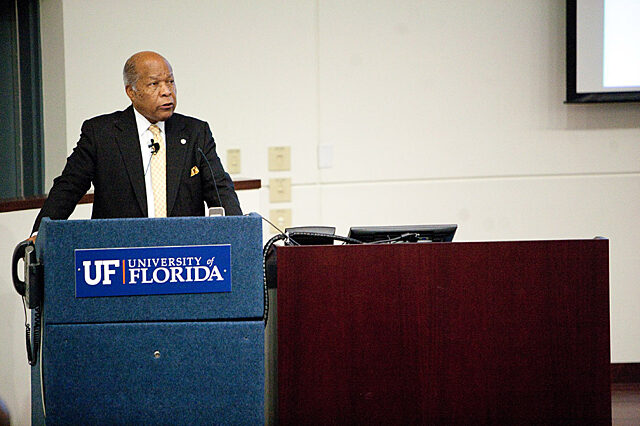Increasing diversity in the health professions can help improve health care, reduce costs

Louis W. Sullivan, M D, a former U.S. Secretary of Health & Human Services and founding dean and president emeritus of the Morehouse School of Medicine spoke about the economic impact of health disparities, during the UF Health Science Center's Diversity Dialogue, March 23. (Photo by Jesse Jones/University of Florida)
High rates of illness among the population and poor access to health care don’t just burden society, they also drive economic costs higher. A major contributor to the rise is the gap in health status known to exist between ethnic minorities and other groups, health researchers say.
One way to help reduce inequities in health and save health care dollars is to increase the proportion of ethnic minorities in the health professions workforce, and, in so doing, provide more culturally sensitive care, said Louis Sullivan, M.D., a former secretary of the U.S. Department Health and Human Services. Sullivan gave the keynote address at the Diversity Dialogue and Student Symposium on Health Professions held recently at the University of Florida Health Science Center.
The U.S. spends trillions on health care each year, reaching $2.5 trillion in 2009, according to an analysis in the public policy journal Health Affairs. A large fraction of that is attributable to health inequities, experts say. For example, from 2003 to 2006, health inequities accounted for $1 trillion in indirect costs associated with illness and premature deaths, according to a study commissioned by the Joint Center for Political and Economic Studies.
“We pay in various ways that we’re not aware of,” said Sullivan, the founding dean and president emeritus of the Morehouse School of Medicine. “Indeed, dollars come out of our pockets because of the ongoing problem of health disparities in our country.”
Illness can rob individuals and families of vital income, while employers lose productivity and have to pay higher insurance costs. Health care organizations spend more to care for sicker patients and sometimes do not recover costs because patients are unable to pay. Governmental agencies lose tax revenue when sickness keeps people unemployed, and the agencies often have to pick up the health care tab for the uninsured.
Even as the number of people requiring health care continues to increase steadily, various studies project that the shortage of health care professionals will top 1 million by 2025.
“Who will provide care?” Sullivan said.
Simply increasing the numbers of health care workers is not enough, however — it is also important to increase ethnic diversity among the health workforce, Sullivan said.
That’s because for patients to interact effectively with the health care system, not only must health care professionals be well-trained in their field of medicine, they also need to be culturally competent.
A striking gap exists between minority representation in the general population and in the health professions. A 2004 study found that although at the time minorities made up more than 25 percent of the population, they accounted for less than 10 percent in various health care professions.
“Why is that important? We have to have professionals who understand the language of the patient, the value systems of the patient, are able to communicate effectively with the patient and are able to develop trust with the patient,” Sullivan said. “If you do not have that, then all of the knowledge in the world goes down the drain.”
UF is doing its part to help address disparities in the health professions, said College of Medicine Dean Michael L. Good, M.D., the Folke H. Peterson Dean’s Distinguished Professor.
“We have increased the number of ‘underrepresented in medicine’ students in our medical school, residents in our house staff program and faculty in our college, and each group and recruit helps us to address health disparities in outpatient practice and hospital care,” Good said.
To effectively counter disparities, educational efforts must start well before students get to the medical school level.
“The big challenge starts in public school — if kids aren’t graduating from high school then they can’t go to college, and if they aren’t graduating from college then they can’t go to medical school, and so on,” said Win Phillips, D.Sc., UF’s vice president for research.
One of the key ways that UF and sister institutions are helping to provide opportunities is through the Florida Alliance for Health Professions Diversity, which offers scholars programs and other youth education initiatives.
“This allows us to better brainstorm about solutions and participate in programs that are statewide,” said Rebecca Pauly, M.D., the associate vice president for health affairs, equity and diversity in the UF Health Science Center, and chairwoman of the alliance. “That means we have a broader audience, and are able to reach more students.”